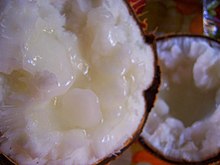Macapuno

Kopyor (pronounced as kop-yor) in Indonesia, macapuno in the Philippines, is a coconut sport or naturally occurring coconut mutant which has an abnormal development of the endosperm. The result of this abnormal development is a soft jelly-like coconut flesh.[1]
Normal coconut flesh mostly consists of galactomannan as a source of energy. In the development process, this substrate is degraded into two sub-components, galactose and mannose. In the mutant the enzyme for degrading this substrate, α-D-galactosidase, is not active. Hence, the endosperm fails to nourish the embryo, resulting in a collapsed embryo. Besides this enzyme, a couple of other enzymes are also suspected of being involved in the development of this trait: sucrose synthase and stearoyl acyl carrier protein desaturase.
Kopyor coconuts have a higher sucrose proportion (92% of total sugar) and contain more total amino acids compared with young mature coconuts. The lipid content in the flesh is also lower compared to young mature coconut flesh. In addition to the higher content of citric and malic acids, all these properties may contribute to the taste of kopyor flesh.[2]
Culinary uses

In Indonesia, kopyor coconut or kelapa kopyor is considered a delicacy. Es kelapa kopyor is a dessert drink which is usually made using this coconut.
References
- ^ Sukendah; Volkaert; Sudarsono (December 2009). "Isolation and Analysis of DNA Fragment of Genes Related to Kopyor Trait in Coconut Plant". Indonesian Journal of Biotechnology. 14 (2): 1169–1178.
- ^ Santoso, Umar; Kubo, Kazuhiro; Ota, Toru; Tadokoro, Tadahiro; Maekawa, Akio (October 1996). "Nutrient composition of kopyor coconuts (Cocos nucifera L.)". Food Chemistry. 57 (2): 299–304. doi:10.1016/0308-8146(95)00237-5.
